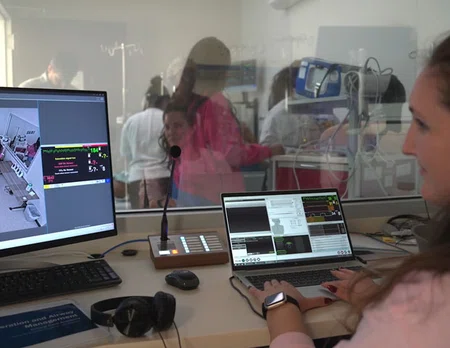© 2024. Houston Methodist, Houston, TX. All rights reserved.


In this
issue

WELCOME
NURSING SCIENCE

Robotic Tutor for Nursing

AI's Role in Nursing

Assessing the Knowledge and Attitudes of Registered Nurses About Artificial Intelligence in Nursing and Health Care
EDUCATION
PRACTICE

The Day in a Life of a Virtual Nurse and a Bedside Nurse

Enhancing Nursing Efficiency and Satisfaction with Smart Room Technology
PROFESSIONAL DEVELOPMENT

My Journey in Nursing: Into the Virtually Unknown

Engineered for Care: How Former Engineers Are Innovating Nursing
MAGNET
FROM OUR TEAMS

ABOUT DISCOVERN
EDUCATION
A New Era for Clinical Simulation: Virtual Reality and Artificial Intelligence
By Hsin-Mei Chen, PhD, MBA
By Hsin-Mei Chen, PhD, MBA

Clinical simulation is crucial to nursing education as it provides a safe environment, without risk, for nurses to practice their knowledge and skills.
Traditionally, simulation scenarios were created by actors to mimic realistic clinical situations, and, sometimes, a mannequin was used to simulate specific patient conditions that a human could not perform. Now, modern technology can enable mannequins to generate heartbeats or lung sounds in different clinical situations. Additionally, some simulators can even produce sweat and tears. The goal of the simulation is to provide standardized training to clinicians before handling real patient situations.
However, traditional simulation is often labor-intensive and cost-prohibitive and requires a designated place, which is usually limited in hospitals. Coordinating space, equipment, and people can make organizing a simulation event challenging. While frequent practice significantly improves skills, achieving the desired learning frequency with the traditional method is difficult.
In recent years, virtual reality (VR) simulation has provided an alternative option for learners to practice skills in a computer-simulated environment or interact with a computer-simulated object in a natural environment. A clinician can perform the simulation anytime, anywhere at a relatively low cost. Moreover, VR simulation provides a more immersive environment without disruptions. Although traditional simulation is best performed with a well-written script, it is not a guarantee that all actors will perform consistently when interacting with different types of learners.
VR simulation offers a pre-made scenario. All the learners will have the same experience, guaranteeing standardized training for everyone. By providing a more realistic and immersive experience, VR simulation allows learners to learn four times faster and with 275% more confidence1. Many studies have shown that training with realism improves communication skills and critical thinking, leading to better clinical judgment and handling emergent situations with confidence2-5.
Creating VR scenarios requires significant computer programming and time. When I reviewed the available resources about four years ago, the initial VR simulation was similar to an arcade game. During this time, artificial intelligence (AI) surged when OpenAI announced its language model. In 2022, ChatGPT was born, followed by advanced semiconductors developed to support AI generation, granting AI tremendous possibilities. In 2023, everyone started talking about AI, and every industry wanted to use AI.
VR simulations have also become more advanced with AI development. Now, learners can practice assessments on virtual humans, which are connected to AI generators. They are good, but they can be improved. Additionally in the future, we may not need to depend on a computer programmer to create the VR simulation. It will take more time to develop; however, I do not think it’s far in the future. When the technology matures, trainers can generate VR simulations based on the specific requirements for the practice setting without waiting for developers.
In the meantime, my team can create in-house VR simulations using videography while exploring the capability of virtual humans and other technology. For our next step, we want to examine using haptic devices to offer learners a realistic sensory touch on the objects. Therefore, we still need traditional simulation to complement the area that VR simulation cannot cover. However, VR simulation has gained attention in the healthcare community due to its feasibility and convenience in a multitude of scenarios.
References:
- PwC. The Effectiveness of Virtual Reality Soft Skills Training in the Enterprise: A Study. PwC; 2020.
- Cho MK, Kim MY. The effect of virtual reality simulation on nursing students’ communication skills: a systematic review and meta-analysis. Front Psychiatry. 2024 Jul 4;15:1351123.
- Kiegaldie D, Shaw L. Virtual reality simulation for nursing education: effectiveness and feasibility. BMC Nursing. 2023 Dec 19;22(1):488.
- Lemée MH, Lavoie S, Provost J, Ledoux I. Exploring the Acceptability and Feasibility of an Immersive Virtual Reality Intervention for Newly Graduated Nurses Working in a Rural Area. Clinical Simulation in Nursing. 2024;91:101542.
- Shorey S, Ng ED. The use of virtual reality simulation among nursing students and registered nurses: A systematic review. Nurse Education Today. 2020 Nov;98:104662.









